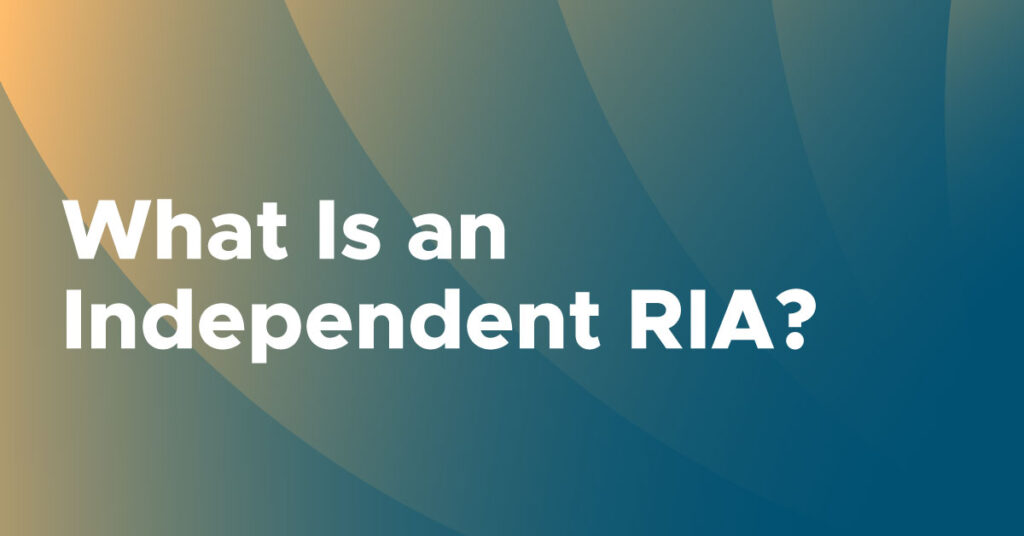
In recent years, the financial advisory landscape has undergone a quiet transformation, one that’s shifting more control and transparency into the hands of both advisors and their clients. At the forefront of this evolution is the independent Registered Investment Adviser, or RIA. As more financial professionals seek autonomy and demand personalized, conflict-free advice, independent RIAs are emerging as a preferred choice.
But what exactly is an independent RIA and how does it differ from other financial advisory models? And most importantly, why are so many advisors choosing this path?
In this article, we’ll break down the fundamentals of independent RIAs, including why going independent allows you to build the practice—and client relationships—on your own terms.
What Is a Registered Investment Adviser (RIA)?
A Registered Investment Adviser (RIA) is a firm or individual that provides investment advice and is registered with either the U.S. Securities and Exchange Commission (SEC) or a state regulatory agency, depending on assets under management. What sets an independent RIA apart is that they operate free from the constraints of large brokerage firms, banks, or wirehouses.
Independence is more than just a label—it fundamentally shapes how advisory services are delivered. Independent RIAs typically have the freedom to select the tools, custodians, and investment strategies that best serve their clients without pressure to promote proprietary products This independence fosters a client-first approach, deeply rooted in fiduciary standards. In short, an independent RIA is legally and ethically bound to act in the best interest of clients, prioritizing transparency, objectivity, and long-term value.
Understanding Independent RIA Firms
Independent RIA firms are known for offering personalized, high-touch service tailored to the specific needs of each client. They’re structured to put clients at the center, often resulting in deeper relationships and more customized financial strategies.
Key characteristics of independent RIA firms
- Fiduciary standard of care: Legally obligated to act in clients’ best interests.
- Transparency: Clear, straightforward fees and open communication.
- Customization: Investment and planning strategies tailored to each client’s goals.
- Open architecture: Freedom to choose from a wide array of financial solutions.
This model is especially attractive to high-net-worth families, entrepreneurs, and wealth creators who seek holistic wealth planning, not one-size-fits-all portfolios.
Types of RIAs: Independent vs. Hybrid
While independent RIAs operate free from affiliations with broker-dealers, hybrid RIAs maintain dual registration—functioning both as an RIA and under a broker-dealer. This hybrid model can provide greater flexibility for advisors transitioning from commission-based practices, but that flexibility often comes at a cost to clients. Because hybrid firms still have broker-dealer affiliations, they carry many of the same conflicts of interest inherent in commission-based structures. In making the leap to an RIA, both advisors and clients should consider how many conflicts they’re willing to tolerate in exchange for a smoother transition.
Independent RIAs are preferable when:
- Individuals value objectivity and transparency.
- Clients seek fiduciary-level service with fee transparency and no embedded product incentives.
- A boutique, client-first experience is desired.
- Advisors want full control over their business, technology, and investment choices without broker-dealer constraints.
Hybrid RIAs may be suitable when:
- A broader suite of investment vehicles (including commission-based products) is desired.
- Advisors wish to maintain the ability to earn commissions on certain products, such as annuities or alternative investments, while expanding their fee-based advisory business.
Advisors can transition to an advisory model more gradually, maintaining access to familiar product options as clients begin to benefit from a more advice-driven relationship. Ultimately, the choice comes down to business model fit and client expectations.
The Key Differences Explained
RIA vs. Broker-Dealer
A broker-dealer primarily facilitates securities transactions and may earn commissions on product sales. By contrast, an RIA provides investment advice for a fee and is held to a fiduciary standard.
- Fiduciary responsibility: RIAs must put clients’ interests first; broker-dealers are typically held to a “suitability” standard.
- Compensation: RIAs charge fees (percentage of assets, flat, or hourly); broker-dealers often earn commissions.
- Conflicts of interest: RIAs aim to minimize conflicts by avoiding compensation structures tied to specific products. Broker-dealers, on the other hand, may have financial incentives to recommend investments that generate higher commissions, which can create misalignment between client goals and product selection.
RIA vs. Financial Advisor
“Financial advisor” is a broad term that encompasses a variety of professionals, including brokers, insurance agents, and RIAs. However, only RIAs are bound by fiduciary duty by regulation.
- RIA: Regulated, fiduciary, typically fee-based.
- Other advisors: May operate under less rigorous standards and compensation models.
RIA vs. Broker-Dealer vs. Wirehouse
- RIA: Independent, fiduciary, customizable solutions.
- Broker-Dealer: Commission-based, product-oriented, less flexible.
- Wirehouse: Large national firms with standardized offerings, proprietary products, and limited customization.
Each model has pros and cons, but the independent RIA model often stands out for those seeking trust, transparency, and tailored solutions.
Advantages of Choosing an Independent RIA
Choosing an independent RIA offers a number of compelling benefits:
- Fiduciary duty: Advice is always in client’s best interest.
- Transparency: Clear communication around fees, performance, and strategy.
- Customization: Solutions are tailored to client’s unique goals, not built around quotas.
- Access: Independent firms can source investment options—both liquid and private—best suited to each client’s goals, without being constrained by proprietary platforms or firm mandates.
- Dedicated Team: Clients are supported by a dedicated team with direct engagement from firm leadership, ensuring decisions are tailored and accountability remains close to the client.
These advantages can make a significant difference in long-term financial outcomes and peace of mind.
Potential Disadvantages of Independent RIAs
Of course, no model is without trade-offs. Some potential drawbacks of independent RIAs include:
- Higher minimums: Some firms may require a minimum level of investable assets.
- Less emphasis on proprietary or in-house research: Independent firms typically prioritize client-specific solutions over maintaining large-scale product or research operations, and often rely on external research instead.
However, many independent RIAs, including Cresset, mitigate these downsides by leveraging best-in-class technology, robust investment platforms, and deep industry partnerships to deliver the scale and sophistication of a large institution with the attention and care of a boutique firm.
Compensation Structure of Independent Financial Advisors
Independent RIAs typically operate under transparent, client-friendly compensation models:
- Fee-only: Advisors are paid a flat fee or percentage of assets under management.
- Fee-based: May include a mix of fees and limited commissions.
- AUM-based: Advisors charge a percentage of the assets they manage.
Transparent pricing aligns the advisor’s success with the client’s, reinforcing trust and long-term relationships.
How To Know Whether a Firm Is an RIA
To verify if a firm is a Registered Investment Adviser:
- Check the SEC’s Investment Adviser Public Disclosure (IAPD) database.
- Review Form ADV, which details an RIA’s services, fee structure, and disciplinary history.
It’s a good habit to confirm registration status and review disclosures before entering any financial relationship.
About Cresset
Cresset is an award-winning multi-family office and private investment firm. We serve entrepreneurs, executives, wealth creators, and multi-generational families with a modern approach to wealth management and a commitment to True Fiduciary® Standards.[1]
As an independent RIA firm founded by families for families, Cresset offers a new paradigm for advisory services. From tax strategy and trust management to exit planning and family governance, our mission is to give our clients time to pursue what matters to them most.
If you’re an advisor considering independence, we invite you to learn more about how Cresset supports breakaway advisors through our dedicated transition program.
Summary
The independent RIA model represents a shift toward greater transparency, deeper client relationships, and a fiduciary-first mindset. While not without challenges, such as navigating regulatory requirements, scaling operations, and maintaining robust compliance, the benefits can be significant. Independent RIAs often enjoy greater flexibility in designing client solutions, stronger alignment of incentives, and the ability to cultivate long-term trust.
If you are an advisor exploring the next stage of your professional journey, understanding the RIA landscape provides a foundation for more informed decisions. By weighing the advantages and limitations of independent and hybrid models, advisors can chart a path toward a more transparent, client-centric financial future.
Ready to Go Independent?
Join advisors who have taken control of their future with Cresset’s support. Gain freedom and flexibility, without starting from scratch.
[1]True Fiduciary®: Please note that the Advisor has affiliations, through common ownership and/or control, with other registered investment advisors, registered financial service institutions, and pooled investment vehicles. The Advisor may recommend its affiliates’ products and services to clients. The True Fiduciary® Standards have been adopted by the Advisor and not its affiliated entities. In no event is a client obligated to use affiliates’ services or purchase products.
About Cresset
Cresset is an independent, award-winning multi-family office and private investment firm with more than $235 billion in assets under management and advisement (as of 10/31/2025). Cresset serves the unique needs of entrepreneurs, CEO founders, wealth creators, executives, and partners, as well as high-net-worth and multi-generational families. Our goal is to deliver a new paradigm for wealth management, giving you time to pursue what matters to you most.
https://cressetcapital.com/disclosures/
